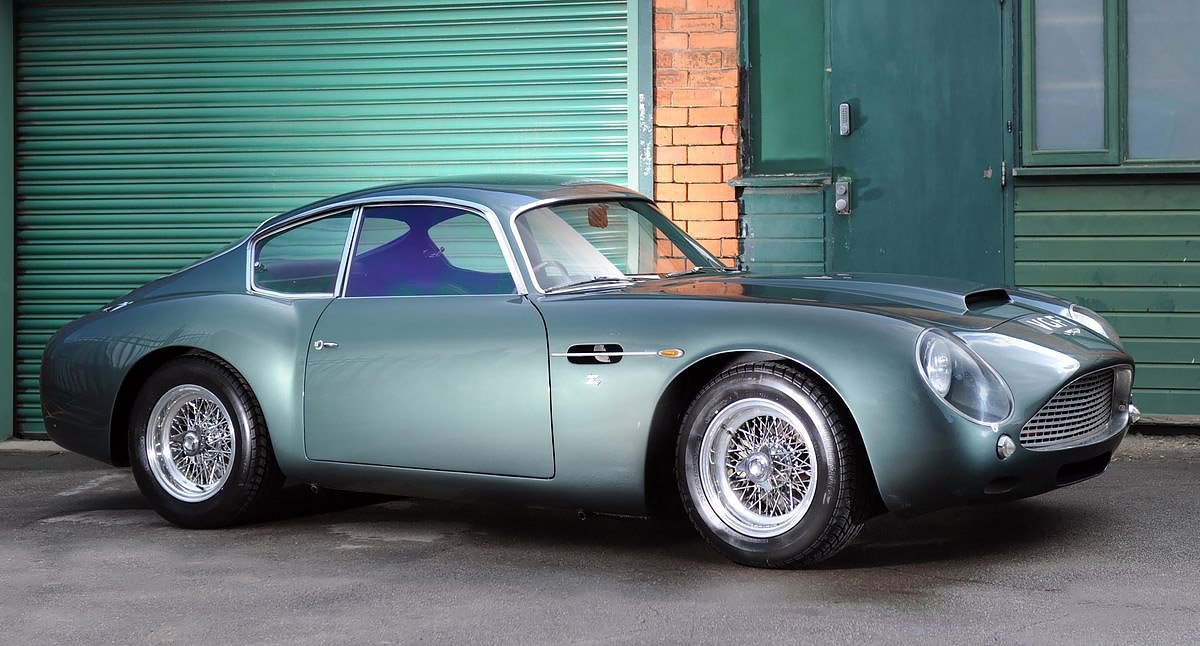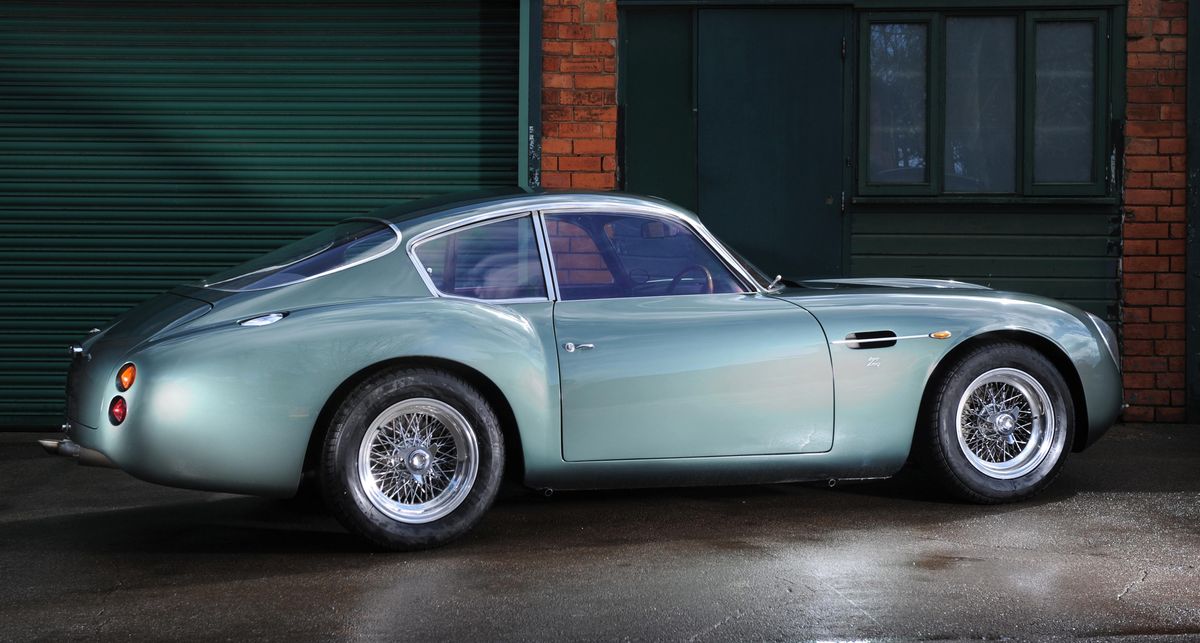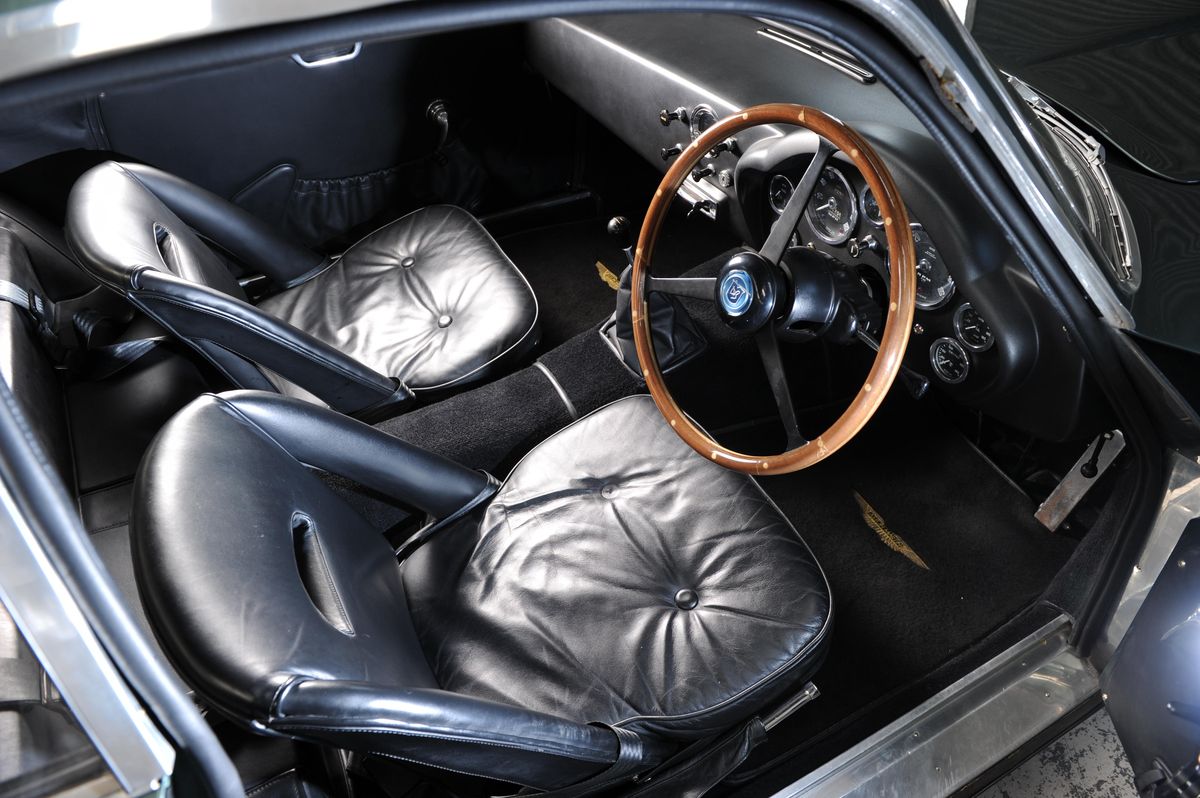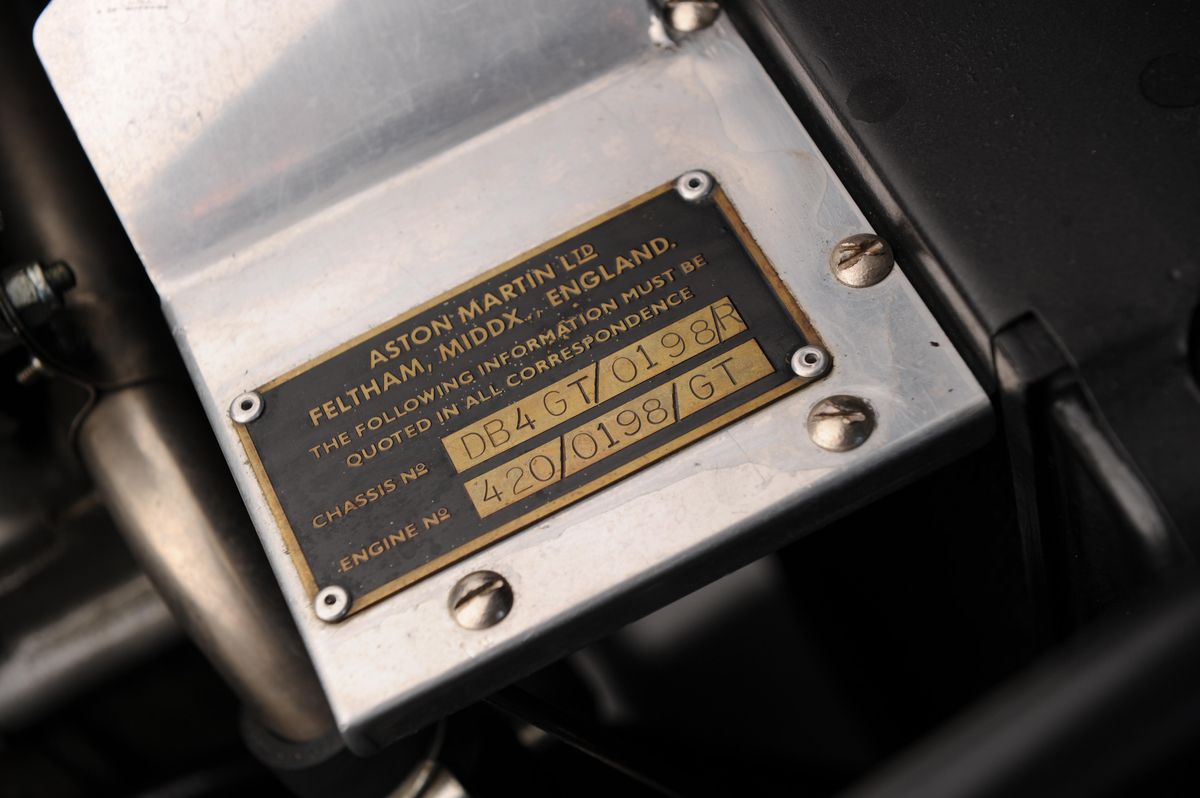
Many enthusiasts will have seen top rank drivers like Moss holding their own in Gran Turismo races with privately owned Zagato-bodied Aston Martin DB4 G.T. cars against works-prepared Ferraris, and will have a good idea as to their performance and road holding capabilities. What they may not have appreciated, particularly if they desire to own such a car and can afford £5,470 to do so, is that it is also a comfortable and surprisingly tractable vehicle for normal road use.
The example tested reached a best one-way maximum speed of 153.5 mph (152.3 mph mean) and covered a quarter-mile from a standing start in 14.5 sec; then it was travelling at over 100 mph, and went on to reach 140 mph in 32.2 sec. Such figures are astonishing by production car standards, but of equal importance is that little drama was involved when achieving them, and that the road manners of the car are fully matched to such performances.

The Zagato body is mounted on a standard Aston Martin G.T. chassis, only the engine being altered in the use of a higher compression ratio, 9.7 compared with 9.0 to 1; as a result it develops 314 b.h.p. — 12 b.h.p. more. The G.T. chassis has a shorter wheelbase than that of the standard DB4 saloon, 7ft 9in. against 8ft 2in., which, in conjunction with the light alloy panelled body, gives a weight saving of over 3 cwt in the total of 24.7 cwt.
In other respects there is little basic difference between the chassis of the G.T. and standard saloon; the wishbone front suspension and live rear axle, controlled by trailing parallel arms at each side and a transverse Watt’s linkage, being identical. Detail changes are made in spring rates, damper settings and steering geometry; the G.T. chassis has Girling disc brakes all round with no servo, whereas the saloon has Dunlop discs with servo assistance.
The main differences in the engine are in the cylinder head and lubrication system — the latter having a cooler in the circuit. The cylinder head has a valve layout similar to that of the DB4, but there are two sparking plugs per cylinder fed from two camshaft-driven distributors. Fuel is metered through three twin-choke Weber carburettors and the camshafts, valves and other details differ slightly.

For these cars the chassis are sent to Italy for Zagato to mount their tubular-framed, light alloy bodies; they are then returned to Aston Martin for trimming and painting. To save weight, the rear and side windows are made of Perspex. Luggage accommodation is confined to a wide platform behind the bucket seats. A considerable amount can be stacked in this space without interfering greatly with rearward vision, but on the test car no retaining straps were fitted, and as a result luggage shifted forward during heavy braking. The manufacturers inform us that these can be specified at no extra charge.
There is virtually no spare space in the tail except for small odds and ends, as it is almost entirely taken up by the fuel tank and horizontally mounted spare wheel. The tank holds 30 gallons, including 5 gallons positive reserve, and has enormous fillers with snap-action caps at each side of the wing valances. Such a fuel capacity provides a touring range at very high cruising speeds of over 350 miles, so that one could, for example, motor to the South of France from Britain with only one re-fuelling stop.

In such a high performance car, driver comfort, field of vision and all the other subtleties of design which combine to give the confidents of full command are of paramount importance; in most respects there is little to criticize on the Zagato. The set of the steering wheel, which has pinch- bolt adjustments for rake and reach, is ideal and the wooden rim does not hinder forward vision; two bulges in the bonnet — to give clearance over the engine valve chests — interfere with some drivers’ view of the nearside wing contour and care is required in placing the car in confined spaces. The thin screen pillars are well raked and there is plenty of headroom to the sides of the curved roof, unlike some other Zagato bodies we have experienced. The aluminium framed Perspex side windows appear rather flimsy, but seated reasonably firmly against their rubber sealing strips at all speeds. Front-hinged rear quarter lights, also made of plastic assist internal ventilation very materially without producing excessive draught or noise. These have smooth- operating over-centre catches which stay in any selected position regardless of the speed.
Comfortable Seats
The main instrument cluster comprising speedometer, tachometer, ammeter and gauges for coolant temperature, oil temperature and pressure, is contained in a separate nacelle finished in matt black and is clearly seen through the three-spoke steering wheel. On the column are two levers, the right one for the hand-cancelled turn indicators, which would benefit from a more powerful warning light or audible clicker, and the left one for the headlamp dip-switch; on the end of each lever is a headlamp flasher button. Pedals with bottom pivots are well arranged with nice angles of movement, the throttle being aligned with the brake for easy heel-and-toe operations; a rubber-covered foot rest is on the left side of the transmission tunnel.
The seats can best be praised by saying that they are scarcely noticed even after long and very fast journeys. The soft upholstery gives excellent support to the thighs and back without any exaggerated padding. On a car of this type some customers might justifiably expect to find lever-type adjusters for the backrests instead of the thumb-screw stops provided; these would also overcome the criticism that the passenger’s seat when not occupied flops forward under braking.
Plenty of safety padding is fitted round the screen, facia (including a passenger grab handle) and door cappings. Yet the twin sun-vizors, which can be moved through wide angles and are softly framed and filled, have extremely dangerous-looking metal pivots in line with the driver and passengers’ heads; in the interests of safety they were removed during most of the test. The heating and ventilation system is adequate without being exceptional. An improvement would be the ability to select cool air through the screen demister slots simultaneously with heat through the scuttle ducts.
The seven instruments important to the driver are clearly visible through the wood-rimmed wheel and are mounted in a cowled nacelle finished in matt black. The seats provide good support and the bottom-hinged pedals are well laid out.
Mention has been made already of some of the outstanding performance figures, and the rest are best studied by reference to the tables and acceleration curve. They are noticeably superior throughout the range to any others ever recorded in an Autocar Road Test, and quite remarkable are the very consistent time intervals for the 20 m.p.h. speed increments recorded in each of the gears — indicating 2 smooth power delivery almost throughout the engine speed range. For the standing start figures the twin-plate clutch, which has a moderate operating load and not unreasonable pedal travel, was engaged at around 4.500rpm at which the drive took up smoothly without continued slip. Aided by the limited slip differential full power could be applied immediately with practically no wheelspin, dramatic swerving or axle judder.

For normal use, the recommended maximum engine speed in the indirect ratios is 5,800 r.p.m., the red line on the tachometer being at 6,000 r.p.m. With the manufacturers’ agreement, we were able to exceed this slightly for performance testing to clear 50 m.p.h. in 1st, 80 mph in 2nd and 120 m.p.h. in 3rd before changing up to the next highest ratio. These gear spacing’s are well chosen, for 1st could be scarcely higher for normal road use and there is a tremendous reserve of punch in 3rd to well over 110 m.p.h. The axle ratio on the test car was 3.31 to 1, but there are options of 2.93, 3.54, 3.77 and 4.09, giving a choice of either improved acceleration or more restful cruising.
The engine was more tractable than expected, and it would pull away smoothly from 1,000 r.p.m. in top gear, but this ability was marred by annoying “ clonks ” in the axle at these low speeds and the differential was not silent at any speed. Carburation was clean throughout the range, cold starting was almost instantaneous, and there was no trouble with a hot engine provided the throttle was held wide open and not pumped. It was noteworthy that the “hot” sparking plugs were not temperamental at sustained power or during continuous part-throttle in traffic — often a weak point of compromise on a relatively highly tuned engine.
Super premium petrol is required, but the engine only pinked slightly when the throttles were slammed open at very low revs, and did not run on after sustained high speed runs. The overall consumption throughout the 1,062 miles test was 13.9 m.p.g., which could undoubtedly be improved to 16-18 m.p.g. with more discreet use of the throttle and by restricting cruising speeds to 100 m.p.h. or less. High performance engines often consume liberal quantities of oil, but the Aston Martin used only two pints throughout the test. The oil cooler in the lubrication system undoubtedly contributes to this economy, and also to the maintenance of a pressure, which never wavered from 120 p.s.i. except at tick-over and a temperature which did not exceed 70 deg. C; the coolant system ran at a similar figure and did not require topping up.
As with most Aston Martins when new, the gear change was rather heavy and lumpy, the movement from 1st to 2nd particularly requiring brute force on the timed runs; it is known from experience that it eases off after a few thousand miles. All forward gears have synchromesh, that on firs* being less effective than on the three other gears; it was often difficult to engage from rest because of clutch drag and in traffic the vintage car technique of slipping it into engagement when rolling to a standstill was used.
| Test Conditions |
| Weather Gusty with 10-20 m.p.h. wind |
| Temperature 44 deg. F. (7 deg. C.). Barometer 28-7in. Hg. |
| Dry concrete and tarmac surfaces. |
| Weight |
| Kerb weight (with oil, water and half-full fuel tank) 24-6cwt (2,765lb-1,251 kg) |
| Front-rear distribution per cent: F, 51; R, 49. |
| Laden as tested 27.6cwt (3,101lb-1,406kg) |
| Turning Circles |
| Between kerbs L, 33ft 9in.; R, 33ft 9in. |
| Between walls L, 35ft 2in.; R, 35ft 2in. |
| Turns of steering wheel lock to lock 2.5 |
| Performance Data |
| Top gear m.p.h. per 1,000 r.p.m. |
| 24-2, Avon Turbospeed; 25-3, Dunlop R5 |
| Mean piston speed at max. power 3,620ft/min |
| Engine revs, at mean max. speed 6,050 r.p.m. |
| (Dunlop R5 tyres) |
| B.h.p. per ton laden 227 |
|
FUEL Super Premium Grade (100 octane RM) |
| Test distance 1,062 miles |
| Overall consumption 13.9 m.p.g. (20.4 lit/100 km.) |
| Normal range 12.19 m.p.g. (23.5-14.8 lit/100 km.) |
| OIL; SAE 30 Consumption: 4,250 m.p.g. |
For the repeated maximum speed and acceleration runs Dunlop R.5 racing tyres were used as a sensible precaution, although the standard equipment Avon Turbospeed Mk. II covers are fully satisfactory for the car’s performance. The recommended maximum pressures of 42 p.s.i. front and 45 rear were observed, and at top speed the car ran very straight and was not much affected by a prevailing gusty side wind or by wind-breaks such as bridges over the road. Thickly painted white lines or prominent joints in the road surface cause some weaving, but no more than with many cars having half the performance of the DB4. As would be expected with tyres built specifically for adhesion and stability at high speeds, they were rather noisy and not as stable as standard tyres when inflated to the lowest recommended pressures, while adhesion in the wet demanded prudence.
When the Turbospeed tyres were fitted, road noise was reduced noticeably and the lowest pressures of 26 p.s.i. front and 28 rear could be used at speeds up to 100 m.p.h. without affecting the car’s stability. At these pressures the ride was noticeably more comfortable; it never became really harsh at the highest settings. In general, the suspension can be considered firm, but the occupants are not jolted about except when the rear axle hits its bump stops, which happens occasionally if a very deep rut or pot-hole is encountered, particularly when the 30 gallon fuel tank is nearly full.
| GEAR PULL | Top | 3rd | 2nd |
| lb per ton | 385 | 560 | 775 |
| Speed range (m.p.h.) | 110-120 | 90-95 | 76-79 |
| Handbrake 0.25g 121ft | |||
| CLUTCH | |||
| Pedal load and travel — 53lb and 5-.75in. | |||
Shattering acceleration and high maximum speeds are useless or even dangerous if road-holding, controllability and general stability do not reach the same standards. It can be stated at once that no such criticism can be levelled at the DB4 G.T. which, in respect of its live rear axle particularly, has been brought to a peak of development which matches many all-independently sprung cars. There is negligible roll, however fast the car is cornered, and ample warning when the limit of tyre adhesion is approaching at this point a small amount of opposite lock in conjunction with the tremendous reserve of power quickly restores stability. Naturally, care must be taken when cornering in the wet, for imprudent use of the throttle will quickly cause the rear end to lose adhesion, but the responsive steering and its inherent self-centring help the driver out of trouble.
The steering is pleasantly light at high speeds without being too heavy in slow manoeuvres, yet is high geared with 2.5 tums from lock to lock in conjunction with a turning circle of under 34 feet. In neutral cornering conditions there is some understeer, but it is less than that of the standard saloon and can be instantly counteracted by a little more throttle if desired.
| GEAR | MPH | KPH |
| TOP (mean) | 152.3 | 245.1 |
| (best) | 153.5 | 247.0 |
| 3rd: | 120 | 193.0 |
| 2nd: | 80 | 128.7 |
| 1st: | 50 | 80.1 |
There can be no complaints about engine roughness or excessive noise; the exhaust note is non-exhibitionist and silencing is as efficient as one can expect with a car of this type. There is no body drumming and the Zagato coachwork was very rigid over comparatively rough surfaces. For long high speed journeys the wind noise is greater than would be expected with such a smooth and apparently good aerodynamic body shape.
| 2.8 | 3.6 | 4.8 | 6.1 | 8.0 | 9.5 | 12.0 | 14.1 | 17.1 | 20.2 | 25.5 | 32.2 | TIME IN SECONDS | |
| 0 | 30 | 40 | 50 | 60 | 70 | 80 | 90 | 100 | 110 | 120 | 130 | 140 | TRUE SPEED m.p.h. |
| 30 | 40 | 51 | 61 | 71 | 81 | 91 | 101 | 111 | 120 | 130 | 140 | CAR SPEEDOMETER |
As these G.T. cars are designed with competition in mind, the front and rear brake hydraulic circuits have separate master cylinders and no servo-assistance is provided. In spite of this, the disc brakes are surprisingly good, having a reasonable pedal load at low speeds as recorded in the performance data, but do not feel so good when applied at over 100 m.p.h. when the operating pressure becomes very high indeed for maximum efficiency. When thoroughly warmed up they improve in this respect, but most would-be owners would undoubtedly welcome some form of servo-assistance for normal road use.
| Speed range and time in seconds | ||||
| m.p.h. | Top | Third | Second | First |
| 10—30 | – | – | – | 2.1 |
| 20—40 | – | 5.4 | 3.1 | 2.0 |
| 30—50 | 6.5 | 5.7 | 3.1 | 2.0 |
| 40—60 | 7.5 | 5.0 | 3.0 | – |
| 50—70 | 6.9 | 5.1 | 3.1 | – |
| 60—80 | 6.8 | 4.9 | 3.3 | – |
| 70—90 | 6.8 | 5.3 | – | – |
| 80—100 | 7.2 | 5.2 | – | – |
| 90—110 | 7.8 | 5.1 | – | – |
| 100—120 | 9.1 | 6.1 | – | – |
| 110—130 | 9.3 | – | – | |
| 120—140 | 12.1 | – | – | – |
The two speed wipers clear a large area of the screen and continue to function effectively at speeds up to 140 m.p.h. A fault occurred in the drive mechanism — the only one experienced on the car during the test — when the drive gears on the passenger’s side stripped.
In sheer performance there are not more than a half-dozen road cars in the world which can match the agility of this special-bodied Aston Martin. Obviously its market is limited by its high price. For those to whom this is no barrier, but who are prepared to pay for an uncommon, well-engineered vehicle which has the ability to perform creditably on a race track and behave with decorum on the public roads with equal facility, it has few rivals.
| BRAKES | Pedal Load | Retardation | Equiv. distance |
| (from 30 m.p.h. in neutral) | 25lb | 0.16g | 188ft |
| 50lb | 0.41g | 74ft | |
| 75lb | 0.67g | 45ft | |
| 100lb | 0.93g | 325ft |
Although some sacrifice in luggage capacity results from the very large fuel tank, one has the advantage of a range of over 350 miles. The spare wheel could not be easier to remove.
Twin distributors are driven from the rear of each camshaft for the two 10 mm sparking plugs per cylinder. A cool air intake box is used for the three twin-choke Weber carburettors and there is a separate coolant header tank on the left wing valance.
The body has unmistakably Zagato lines. Bumpers are not available and this would make the light alloy bodywork over-vunerable for every day use.
Each seat back has knurled abutment screws for adjustment of rake. A considerable amount of luggage can be accommodated on the upholstered platform, beneath which the battery is mounted on the driver’s side.
| Car | Aston Martin DB4 GT Zagato |
| Made in | UK |
| ENGINE | |
| Type | Aston Martin manufactured R6 |
| Cylinders | 6 in line, aluminium head and cylinder block |
| Bore | 92 mm (3.62in.) |
| Stroke | 92mm (3.62in.) |
| Displacement | 3,670 c.c. (224 cu. in.) |
| Valve gear | Twin overhead camshafts |
| Compression ratio | 9.7 to 1 |
| Carburettors | 3 twin-choke horizontal Webers, type 45 DCOE4 S.U. |
| Fuel pump | electric, Duplex high pressure type |
| Oil filter | Purolator full flow, replaceable element |
| Max. power (net) | 314 b.h.p. at 6,000 r.p.m. |
| Max. torque | 278 lb. ft. at 5,400 r.p.m. |
| TRANSMISSION | |
| Clutch | Borg and Beck 9.0in. dia. twin dry plate |
| Gearbox | D.B. four-speed all synchromesh |
| Overall ratios | Top 3.31, 3rd 4.14, 2nd 6.13, 1st 8.25, reverse 8.07 |
| Final drive | Hypoid bevel, 3.31 to 1; with Powr-lok limited slip differential |
| CHASSIS | |
| Construction | Separate steel platform type |
| Body | Light alloy panels on tubular steel framework |
| SUSPENSION | |
| Front | Independent, wishbones with coaxial coil springs and Armstrong telescopic dampers, anti-roll bar |
| Rear | Live axle with coil springs and Armstrong lever arm dampers: located by parallel trailing links and transverse Watt’s linkage |
| Steering | Rack and pinion; three-spoke light alloy wheel with wooden rim, 16in. dia,; adjustable column |
| BRAKES | |
| Type | Girling hydraulic, separate master cylinders; discs F and R, no servo |
| Dimensions | F, 12in. dia.; R, 11 in. dia |
| Swept area | F, 299 sq. in.; R, 201 sq. in (362 sq. in. per ton laden) |
| WHEELS | |
| Type | Borrani centre-lock wire-spoked, with light alloy rims 5.0in. wide. |
| Tyres | 6.00 x 16in. Avon turbospeed Mk 11. Optional, Dunlop R5 (used for maximum speeds) |
| EQUIPMENT | |
| Battery | 12 volt, 51 amp. hr. |
| Headlamps | Lucas Le Mans 700, 45-40 watt |
| Reversing lamp | Standard |
| Electric fuses | 8 |
| Screen wipers | Two blades, two-speed, self-parking |
| Screen washer | Lucas electric pump type |
| Interior heater | Fresh air type with single speed fan |
| Safety belts | No anchorages provided |
| Interior trim | Leather seats, plastic roof lining |
| Floor covering | Wilton carpet |
| Scarting handle | None |
| Jack | Pillar type, winding handle |
| Jacking points | 2 each side under body sills. |
| Other bodies | Standard GT Coupe |
| MAINTENANCE | |
| Fuel tank | 30 lmp. gallons (including 5 gal. reserve) |
| Cooling system | 3.5 lmp. gallons |
| Engine sump | 23 pints including filter and cooler. S.A.E. 30, change oil each 2,500 miles; renew filter each 5,000 |
| Gearbox | 3 pints S.A.E.40. Change oil each 10,000 miles |
| Final drive | 3 pints S.A.E. 90 (hypoid). Change oil each 10,000 miles |
| Routine greasing | 7 points each 2,500 miles, 5 more at 5,000 miles |
| Tyre pressures | Avon Turbospeed F, 26; R, 28, p.s.i. (normal). F, 33; R, 35, p.s.i. (fast driving). Dunlop R5 F, 42; R, 45, p.s.i. (max. speed runs) |





